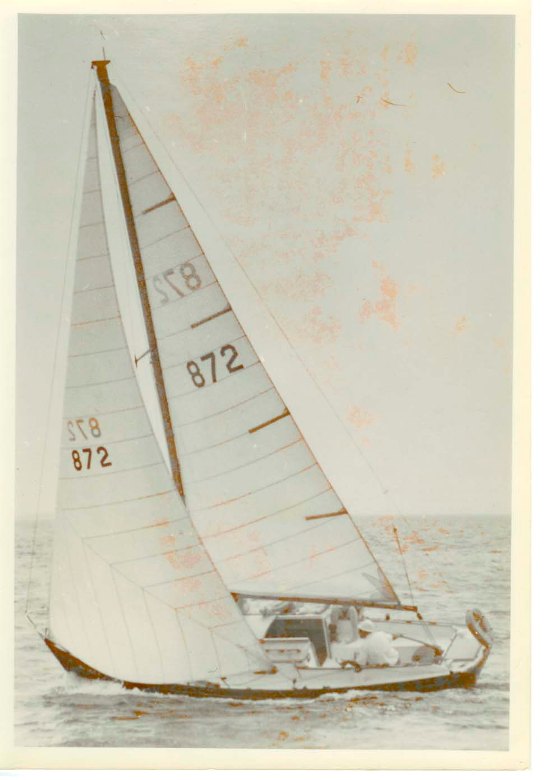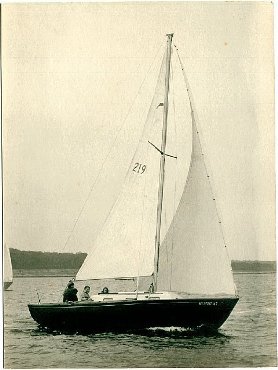|
| |
|
| Ed Colie's Sambo, a 1961/1962? O'Day Dolphin, Mystic, Connecticut, and Staten Island, New York/Sandy Hook, New Jersey (updated March 27, 2012) |
|
| |
|
Thanks to George Watts (Odile) we have the following circa 1973 of Ed Colie sailing his Sambo.

We have some information about Sambo from an email Ed Colie's son Matt sent to Randell Zempel (former owner of Phar Lap) in November, 1998. Ed was the first owner of this boat and had it for 15+ years. He sold her to George Watts of Guilford, CT where she became Odile and sailed with the other Sachem Head Yacht Club Dolphins, Shamon, Lady, Savili, The Rachael K, Lady, Nalina and Tiki. We have not yet made contact with Matt but we are working on it.
In this interesting email Matt talks about the Dolphin 24 story as he understood it. There are a number of inaccuracies and your webmaster has inserted comments here and there (in red). Here it is below
Date: Wed, 04 Nov 1998
From: Matthew Colie
To: rzempel
Subject: Re: S&S Dolphin 24
About the Dolphin
The story of the Dolphin as I remember the parts and pieces of 38 years gone by.
In the early sixties, O'Day (at that time a division of U.S.Yachts - not so, US Yachts was formed after O'Day) approached the firm of Sparkman & Stevenson for a design for a trailerable (in those days that meant a beam less than 8 feet) pocket cruiser / daysailor with reasonable performance. The O'Day/US Yachts relationship is not clear. Click here to find out more . And how the Dolphin actually came to be is covered on the home page (if not already burned into your memory click here to go to it)
I don't know if you are aware, but in design and development areas, when someone is hired by a firm; he may be required to sign an agreement that any designs, developments or patents not specifically excluded become the property of the firm. These "agreements" used to be standard, all encompassing and potential problem for the employee.
In searching the existing designs for a reasonable starting place, they discovered that something fitting the bill was the design done by an associate, and not mentioned in the exclusions and therefore available to them. (William-I believe) Shaw had produced the design for the Shaw 24 some time before, and they had been a successful boat in wood. (Unfortunately I have forgotten who the actual builder was. Jenson/Denmark) So, they tapped Shaw for his design.
I am not sure of the whole story right at this point, because even at the time the story was somewhat muddy, but the issue caused some hard feelings to those involved either because Shaw received no specific compensation for the design done prior to association, or maybe just that it was published as an S&S design without any credit given directly to him. Some place I even heard it said that it was design he had done while employed by S&S, but not he had not been in a design role so he felt that the agreement was not binding in this case. Webmaster Note: Bill Shaw worked at S&S for about 10 years. He was present and involved in the birth of the Dolphin whose birth certificate clearly mentions his Trina, and his initials are on the document that Olin Stephens wrote. At Mystic Seaport's Designer's Rendezvous in 2001 (Shaw 24 #1, Trina, was there), and at S&S's 75th Anniversary in 2004, Olin Stephens and Bill Shaw seemed very much at ease together as they stood by the stern of my Marionette discussing the relative merits of the nearby Tartan 27 and the Dolphin. Olin's parting words were:
"I've always liked the lines of the Dolphin"
The existing design was translated to plastic the way it always was in those days. So the hulls were very heavy being of solid glass at planking thickness. There were very few cored hulls in those days, and not many at all in fair sailing hulls. There were two significant changes in the Dolphin. The mast step was supported by a huge aluminum arch that is included in the midship bulkhead. This makes a very open cabin not duplicated on any other boat this size. The Shaw boats all had a post that had to be set in place before tightening the rig to go to weather. The companion way was also wider and tapered as was allowed by fiberglass construction that did not require a deck beam at the forward end of the cockpit. Another change that caused some discussion was the rudder. The Shaw was a the typical (for the day) semi-elliptical, but the S&S design came out with the standard for them at the time which was a quadrilateral with the top trailing edge at the after waterline (this theoretically pulled the functional waterline farther aft).
The first Dolphin hulls were laid up at Lunn Laminates on Long Island. (wrong - at Marscot)) These were the same people doing the Chevrolet Corvette bodies. They did the Dolphin hulls for the first couple of years, our first one was supposed to have come from there, but that hull had some assembly problems and my father did not accept it even after the attempts to repair it. Webmaster Note: April 29, 2011. So where did Sambo come from - Marscot/O'Day? Maybe Marscot/O'Day had enough parts left over that they were able to make a boat even while Lunn was building them. This might also explain how Flipper, Hull #41 got built? This hull # is 'out of sequence' see Number of Boats Built and by Whom. Before Lunn started their production run of 25 boats in early 1961 at least up to 29 boats were built by Marscot Plastics, later a subsidiary of O'Day. The 'rejected boat' story is very Interesting . Roy Berg, former chief engineer of Lunn Laminates tells us his personal boat, which he named Black Dolphin, was a brand new boat rejected by the customer. He bought it a discount price, fixed it and sailed/raced it for 5 years before selling it to Walter Strang. Black Dolphin is now owned by Larry Taylor. Click here to go to Black Dolphin.
For the rest of O'Day's production, the molds were moved to a molder (name forgotten) in Fall River. Back to Marscot Plastics During that move there was also something done to the molds. I believe they thickened the keel section. This was discovered as several boats of the class were in the same yard one winter and one of the owners noted that some keels looked thicker than others. Though both floated at near the same LWL, the earlier boats were two to four hundred pounds lighter than the later hulls. To my knowledge there was no published variation in ballast weight. Very interesting - maybe these boats were Yankees if this comparison took place in the late 1960's? They had 200 lbs less displacement with 200# more ballast - same waterline length. Also, some boat owners were known to have added up to 400 lbs of additonal ballast.
If you consider the three different hulls, Shaw, Lunn & Fall River Marscot one of the truly interesting things was that they typically rated within two-tenths of a foot of each other. This was before PHRF, and all the large boat rating systems were measured rules. They typically performed just about that way. We raced our black hulled Dolphin for many years in Lower Harbor (water west of Staten Island and inside Sandy Hook), Long Island Sound and east to Nantucket. So we did see a lot of other boats. We frequently held the class to a division between the Shaws and the Dolphins. In light air to weather the Shaw seemed to do best; the Lunn boats would be right with them, but if it blew a little harder the later hulls would take just a bit more before the rudder started to aspirate.
We had a trailer for Sambo (this was before the current ethic objects), and were one of several people we knew that trailed them. This was a somewhat difficult operation as trailer launching was not really possible (we never even tried with our trailer). Fortunately, travel-lifts were replacing marine railways all over the place. A typical rig stood ten feet over the road and weighed in at about seven thousand pounds, so towing any distance was a serious enterprise.
For a while at least, there was a functional Dolphin association. There were rondesvous and the odd one design race. As there was no "class rule" the owners basically looked over modifications and either Storm Trisail or Off-Soundings rating sheets and usually decided to race as a one design class anyway. There some times that there were two classes split only as spinaker and non, and that was only because some didn't have spinakers (I never did figure out why not).
This design was the inspiration for the Tartan 27. That was actually specified to be like the Dolphin, but have full standing headroom, and an enclosed head. It was basically a good idea, but the T27 never did do as well.
The molds went on to two other builders that I know of, one was called a Yankee Dolphin and the other I do not know. The other builder was Pacific Dolphin.The molds did not go to Yankee - they built their own molds and when they went out of business Pacific used the Yankee molds For more on this click here. I was only able to identify it by first description and then line drawing confirmed. These boats had what I call a house trailer interior as they were not set up to work or sleep a crew with the boat underway.
Matt Colie
*******************
 May 9, 2009. I have spoken with Roy Berg several times since starting this website. He is now 88 and one of the few guys left who were there at the beginning. As Lunn's former chief engineer, and the first owner of a rejected black Dolphin, he is sensitive to the issue of Lunn built rejected Black Dolphins. May 9, 2009. I have spoken with Roy Berg several times since starting this website. He is now 88 and one of the few guys left who were there at the beginning. As Lunn's former chief engineer, and the first owner of a rejected black Dolphin, he is sensitive to the issue of Lunn built rejected Black Dolphins.
He remembered this particular rejected black Dolphin - a couple of years ago he told me the same story Matt relates above. And he added some detail - some years after the rejected boat incident, while cruising, he met this same guy in Port Jefferson, also on a cruise, and they rafted up together. He noted that his Lunn built Dolphin floated about 2 inches higher than the other guy's.
In the conversation I had yesterday with Roy, when asked to go over again this incident half a century ago, he mentioned that that it was a fellow by the name of Ed that had ordered a black hull Dolphin from Lunn and did not accept at delivery for a quality related problem. Then Roy said he did not know Ed's last name, but he remembered that Ed's boat's name was Sambo!! Bingo!!
Roy also recalled Ron Noe and his Lunn built En Charette were there in Port Jefferson as well.
*******************
|
|
| |
|
|
